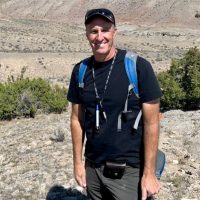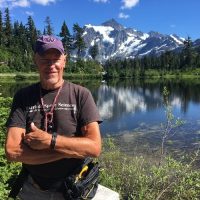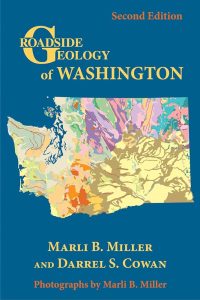Locals interested in learning more about Washington State geology may be familiar with Roadside Geology of Washington (2nd ed.), authored by UW geology alum Marli Miller (M.S., 1987; Ph.D., 1992) and Professor Emeritus Darrel Cowan. Farther afield, Marli has generated public-geology books about Oregon and Death Valley. Marli’s contemporary in grad school at UW, Rob Thomas (Ph.D., 1993), has also been heavily involved in public geological education and is co-author of Roadside Geology of Montana and Roadside Geology of Yellowstone Country.
ESS alums who have taken field camp in Dillon may well have met Rob Thomas, who teaches at Montana Western, lives in Dillon, and helped UW ESS develop the Montana field course, led for many years by Darrel Cowan. Marli has also brought [Oregon] students to Dillon for field camp, and ESS alums who have taken Darrel’s geology trip to Death Valley may have met Marli there, where she has done both research and teaching.

A Senior Instructor II in the Department of Earth Sciences at the University of Oregon, Marli Miller has focused on teaching, ranging from Geology 101 to Structural Geology (her specialty) and Field Camp. In addition to the Roadside books, she has generated two volumes in the Rocks! series – Oregon Rocks! and Colorado Rocks! (the latter with Magdalena Sandoval Donahue), with Death Valley Rocks! upcoming. Marli is also an expert geo-photographer and makes her photos (and an occasional blog post) freely available at https://geologypics.com/. Marli writes, “I love geology and talking about it —and I find that most people I know get pretty excited by the topic. I like to think that the more awareness we have of Earth processes and geologic time, the more we’ll be able to approach a whole host of environmental and even cultural issues with thoughtfulness and humility.”

Regents Professor of Geology in the Environmental Sciences Department at University of Montana Western, Rob Thomas also sees public education as a primary calling. At present, Rob is also working on a Rocks! book – Montana Rocks!, hoping to complete it next year. In addition, Rob has generated educational brochures (some as student projects), run GeoVenture field trips with GSA, generated 25 geologic road signs (with Sheila Roberts), and taught trekking and climbing guides in the Himalaya. His Montana Geology Facebook page has more than 16,000 followers. Rob writes, “My primary interest throughout my geologic career has been public outreach. I enjoy traditional academic research and understand it is necessary for me to stay on top of my discipline, but…[g]iven the status of public understanding of how the Earth works in America, I can think no better way to use my time and training.”

Marli and Rob have great memories of ESS (then Geological Sciences), where they were both denizens—in fact, office mates–of “the Barn” (a rickety 1908 wooden structure in Johnson courtyard that deserves its own story). Rob writes, “My interest in teaching was strong while a student at the University of Washington. I had a few excellent role models…, and many chances to teach through my work as a teaching assistant.” He also recalls “realizing the importance of the use of good research for public good through the work on the Cascadia tsunami project with Jody Bourgeois and Brian Atwater.” Some of Marli’s favorite memories include “going on Darrel’s extended field trips to the desert SW, walking into Floyd’s office to use the fancy typewriters, and always feeling welcomed, interacting with other grad students in the Barn.”
Amongst others, both Marli and Rob cite Darrel Cowan as an inspiration and role model. In addition to Darrel’s aforementioned co-authorship of the Roadside Geology of Washington, he has recently been featured by Nick Zentner in an interview podcast and on YouTube videos in Nick’s “Exotic Terranes A to Z” series. These public-education productions include one of Darrel’s long-term research areas, the San Juan Islands, where he has also run many field trips. Last but not least, a major public contribution Darrel has made has been his founding and maintenance of the Shoshone Education and Research Center (SHEAR) just outside Death Valley National Park. Research and teaching groups from around the country and beyond, including many ESS students, have been able to use this facility, at reasonable rates, while they learn about the geology and natural history of the region.


